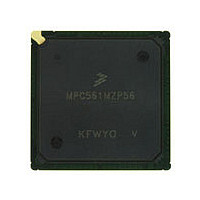MPC561MZP56 Freescale, MPC561MZP56 Datasheet - Page 305

MPC561MZP56
Manufacturer Part Number
MPC561MZP56
Description
Manufacturer
Freescale
Datasheet
1.MPC561MZP56.pdf
(1420 pages)
Specifications of MPC561MZP56
Cpu Family
MPC56x
Device Core
PowerPC
Device Core Size
32b
Frequency (max)
56MHz
Interface Type
QSPI/SCI/SPI/UART
Total Internal Ram Size
32KB
# I/os (max)
56
Number Of Timers - General Purpose
22
Operating Supply Voltage (typ)
2.6/5V
Operating Supply Voltage (max)
2.7/5.25V
Operating Supply Voltage (min)
2.5/4.75V
On-chip Adc
2(32-chx10-bit)
Instruction Set Architecture
RISC
Operating Temp Range
-40C to 125C
Operating Temperature Classification
Automotive
Mounting
Surface Mount
Pin Count
388
Package Type
BGA
Program Memory Type
ROMLess
Program Memory Size
Not Required
Lead Free Status / RoHS Status
Not Compliant
Available stocks
Company
Part Number
Manufacturer
Quantity
Price
Company:
Part Number:
MPC561MZP56
Manufacturer:
Freescale Semiconductor
Quantity:
10 000
Company:
Part Number:
MPC561MZP56R2
Manufacturer:
Freescale Semiconductor
Quantity:
10 000
- Current page: 305 of 1420
- Download datasheet (11Mb)
8.1
The system clock can be provided by the main system oscillator, an external clock input, or the backup
clock (BUCLK) on-chip ring oscillator, see
The main system oscillator uses either a 4-MHz or 20-MHz crystal to generate the PLL reference clock.
When the main system oscillator output is the timing reference to the system PLL, skew elimination
between the XTAL/EXTAL pins and CLKOUT is not guaranteed. There is also an on-chip crystal
feedback resistor on the MPC561/MPC563; however, space should be reserved for an off-chip resistor to
allow for future configurations.
The external clock input (EXTCLK pin) can receive a clock signal from an external source. The clock
frequency must be in the range of 3-5 MHz or, for 1:1 mode, at the system frequency of at least 15 MHz.
When the external clock input is the timing reference to the system PLL, the skew between the EXTCLK
pin and the CLKOUT is less than
The backup clock on-chip ring oscillator allows the MPC561/MPC563 to function with a less precise
clock. When operating from the backup clock, the MPC561/MPC563 is in limp mode. This enables the
system to continue minimum functionality until the system is fixed. The BUCLK frequency is
approximately 11 MHz for the MPC561/MPC563 (see
complete frequency range).
For normal operation, at least one clock source (EXTCLK or main system oscillator) must be active. A
configuration with both clock sources active is possible as well. At this configuration EXTCLK provides
the system clock and main system oscillator provides the PITRTCLK. The input of an unused timing
reference (EXTCLK or EXTAL) must be grounded.
8.2
The PLL allows the processor to operate at a high internal clock frequency using a low frequency clock
input, a feature which offers two benefits: reduces the overall electromagnetic interference generated by
the system, and the ability to oscillate at different frequencies reduces cost by eliminating the need to add
an additional oscillator to a system.
The PLL can perform the following functions:
Freescale Semiconductor
•
•
•
1. Resistor is not currently required on the board but space should be available for its addition in the future.
Frequency multiplication
Skew elimination
Frequency division
System Clock Sources
System PLL
Figure 8-2. Main System Oscillator Crystal Configuration
Figure 8-2
MPC561/MPC563 Reference Manual, Rev. 1.2
±
1 ns.
CL
XTAL
illustrates the main system oscillator crystal configuration.
Figure
1 M
Ω
8-1.
1
EXTAL
Appendix F, “Electrical
CL
Characteristics” for the
Clocks and Power Control
8-3
Related parts for MPC561MZP56
Image
Part Number
Description
Manufacturer
Datasheet
Request
R

Part Number:
Description:
MPC5 1K0 5%
Manufacturer:
TE Connectivity
Datasheet:

Part Number:
Description:
MPC5 500R 5%
Manufacturer:
TE Connectivity
Datasheet:

Part Number:
Description:
MPC5 5K0 5%
Manufacturer:
Tyco Electronics
Datasheet:

Part Number:
Description:
MPC5 5R0 5%
Manufacturer:
Tyco Electronics
Datasheet:

Part Number:
Description:
MPC5 50K 5%
Manufacturer:
Tyco Electronics
Datasheet:

Part Number:
Description:
MPC5 1R0 5%
Manufacturer:
Tyco Electronics
Datasheet:

Part Number:
Description:
TOWER ELEVATOR BOARDS HARDWARE
Manufacturer:
Freescale Semiconductor
Datasheet:

Part Number:
Description:
TOWER SERIAL I/O HARDWARE
Manufacturer:
Freescale Semiconductor
Datasheet:

Part Number:
Description:
LCD MODULE FOR TWR SYSTEM
Manufacturer:
Freescale Semiconductor
Datasheet:

Part Number:
Description:
DAUGHTER LCD WVGA I.MX51
Manufacturer:
Freescale Semiconductor
Datasheet:

Part Number:
Description:
TOWER SYSTEM BOARD MPC5125
Manufacturer:
Freescale Semiconductor
Datasheet:












